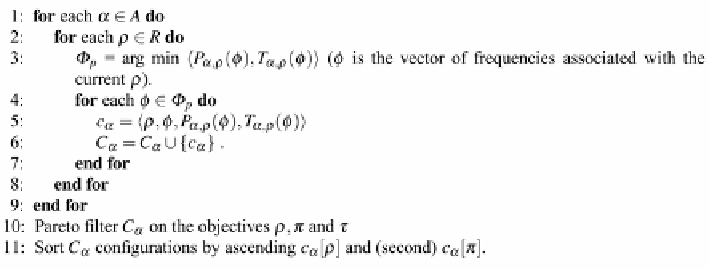Hardware Reference
In-Depth Information
Fig. 5.2
Design-time methodology for identifying the initial
C
α
, for each application
α
and modeling techniques (see Chaps. 3 and 4) supported by DSE tool. The following
algorithm describes sequence of steps taken during our design-time methodology.
Algorithm in Fig.
5.2
shows the structure of adopted design-time methodology.
The algorithm mainly performs the minimization of the execution time and power
consumption for each application version (i.e., for each application
α
and each
available version of
α
which is parallelized over
ρ
resources).
Once all results are collected, these are sorted for obtaining a further speedup at
run-time. A more detailed step-by-step description follows:
Steps 1, 2 and 3
: The algorithm loops over the set of available applications
A
(Step
1) and the set of resources
R
(Step 2) by solving a multi-objective minimization
problem with respect to both
P
α
,
ρ
(
φ
) and
T
α
,
ρ
(
φ
) (Step 3). In our case,
P
α
,
ρ
(
φ
)
and
T
α
,
ρ
(
φ
) are, respectively, the average power consumption and the execution
time delay returned by the architectural simulator for a frequency configuration
vector
φ
. Note that the independent variable to be optimized is
φ
since
ρ
is set as
a constraint in the loop (Step 2).
Since the size of the design space increases rapidly with
ρ
, while for
ρ
≤
3a
full search exploration is performed, for
ρ
4 the problem is solved by using
the NSGA-II multi-objective genetic algorithm [
10
]. The genetic algorithm is run
with a population size
≥
ρ
for 50 generations. The set
p
contains all the
Pareto configurations associated with the solution of the problem.
Steps 5 and 6
: The set
p
is used to construct the operating points and insert them
into the associated
C
α
.
Step 10
: It prunes
C
α
from all the configurations that do not represent an efficient
trade-off in terms of resources, energy and execution time.
Step 11
: It sorts the resulting
C
α
to improve the performance of the run-time
algorithm while finding an operating point with a lower resource usage while
achieving
τ
max
.
The proposed heuristic methodology is able to save a considerable number of simula-
tions. The exact amount of simulation time saving depends on the specific application
scenario as well as from the selected optimization algorithm used for solving the
|
|×

Search WWH ::

Custom Search